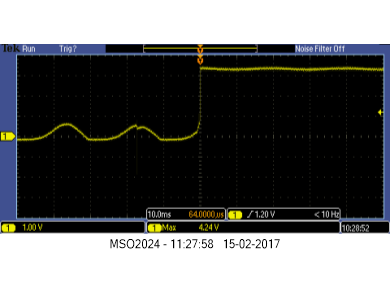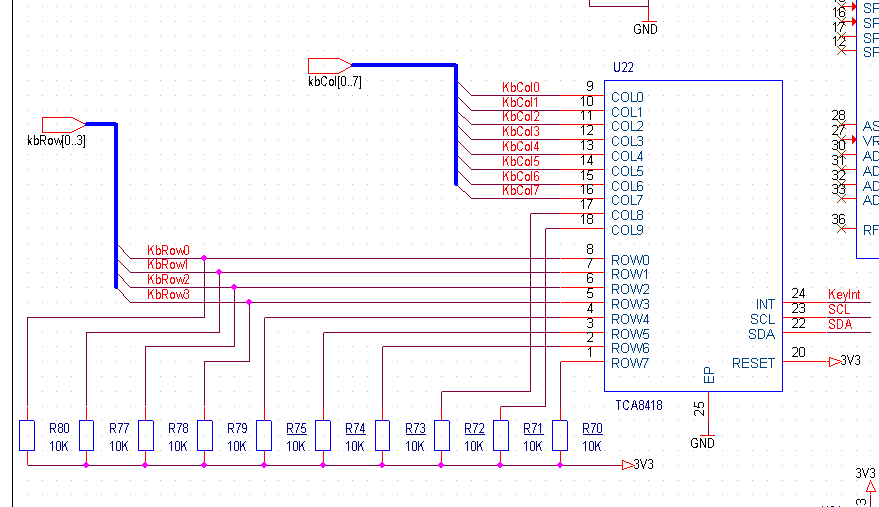Other Parts Discussed in Thread: TCA8418,
Description of Error with TCA8418
I have two IC on the same I2c network. The first is a PCA9685 PWM controller and the other is the TCA8418E. If I run the code for the on or the other, there is no problems. I can also run it in a mode, where, when I press a buttom I turn on a pwm output, and then on nest timer slot turn it of.
The problem arise when I make it do a bit more.
The timer is 10 ms. so when a key is pressed I turn the pwm to 100%. after 5 ticks I turn it dowm to 50% then 25 tick later I switch it of.
I can run for about 30-150 keypress, then the colums goes into a HI imp state
My theory is that i has to do with activ I2C bus and a interrupt fra a key.
When the interrupt comes frrom the tca8418 I just it a bit in software and wait to net timetick to handle it.
After it stops I can still read register of the TCA8418, and they are the same. It just stops reading. And if the colums are in HI imp, then it dont know the a key is pressed.
Here is how they look, when no key is pressed and when a key is pressed.
Normally it looks like this:
Schematic:
void TCA8418::initialize()
{
//initialize communication with TCA84818
i2c.frequency(100000);
char cmd[2];
cmd[0] = REG_CFG; //pointer byte to CFG register
cmd[1] = 0x91; //data for CFG register KE_IEN set to 1
if ( i2c.write(KB_BASEADRS,cmd, 2) == I2C_ACK ) { //initiate write cycle and check for ACK
//intialize all registers from TCA8418 here
cmd[0] = REG_INT_STAT; //pointer byte to Interrupt Status Register
cmd[1] = 0x01; //Reset KE-INT flag
i2c.write(KB_BASEADRS,cmd, 2 ); //Write to Interrupt Status Register from TCA4818
//Set TCA8418 to Keypad mode
cmd[0]=REG_KP_GPIO1; //KP_GIO1
cmd[1]=0x0F; //Set to Keypad mode
i2c.write(KB_BASEADRS,cmd, 2);
cmd[0]=REG_KP_GPIO2; //KP_GIO2
cmd[1]=0xFF; //Set to Keypad mode
i2c.write(KB_BASEADRS,cmd, 2);
cmd[0]=REG_KP_GPIO3; //KP_GIO3
cmd[1]=0x00; //Set to Keypad mode
i2c.write(KB_BASEADRS,cmd, 2);
//Set TCA8418 to Keypad mode
cmd[0]=REG_DEBOUNCE_DIS1; //KP_GIO1
cmd[1]=0x0F; //Set to Keypad mode
i2c.write(KB_BASEADRS,cmd, 2);
cmd[0]=REG_DEBOUNCE_DIS2; //KP_GIO2
cmd[1]=0xFF; //Set to Keypad mode
i2c.write(KB_BASEADRS,cmd, 2);
cmd[0]=REG_DEBOUNCE_DIS3; //KP_GIO3
cmd[1]=0x00; //Set to Keypad mode
i2c.write(KB_BASEADRS,cmd, 2);
} else {
//No response from TCA8418 keyboard chip
// FAIL = 1; //Switch on FAIL indicator
}
}
char TCA8418::GET_KEY()
{
// Key_led = !Key_led; // : toggle LED 2
char cmd[2];
//Read interrupt status flag
char key_hit_ID=0;
ReadReg(REG_INT_STAT);
while (ReadReg(REG_KEY_LCK_EC)) { //Read Key Lock and Event Counter
key_hit_ID = int(ReadReg(REG_KEY_EVENT_A)); //Keypress --> read data from keybuffer
if (key_hit_ID & 0x80) release=0; else release=1;
}
//Reset interrupt flag
cmd[0] = REG_INT_STAT; //pointer byte to Interrupt Status Register
cmd[1] = 0xFF; //Reset KE-INT flag
i2c.write(KB_BASEADRS,cmd, 2);
return key_hit_ID;
}





